
Overview
• Upwards revisions to past data for household
income and profits, as well as partial data
pointing to strong growth in Q3, see us revise up
our outlook for GDP growth out to mid-2024.
• For the full year, we see GDP growth of 2.3%
(from 2.1%) in 2023 and growth in 2024 and 2025
of 1.2% (previously 0.8% and 1.7% respectively).
• We have maintained our view that the Fed won’t
hike again this year, but acknowledge it is
possible, particularly if upcoming inflation data
are on the high side.
• We now don’t see the Fed cutting rates until June
2024 (previously March 2024).
The past looks better
The third estimate of US GDP for Q2 2023 was released in
late September. We have noted in previous US Economic
Update reports the large difference between real GDP
and GDI growth (which conceptually should be equal).
GDP growth over the year to Q2 was revised down only
slightly (-0.1ppts) and GDI growth over the same period
was revised up 0.7ppts. Even after these changes, the
two measures continue to offer very different takes on
the strength of the economy. As normal, we continue to
take the GDP numbers at face value (and they also seem
more in line with labour market indicators) but it may be
that GDP is overstating growth.
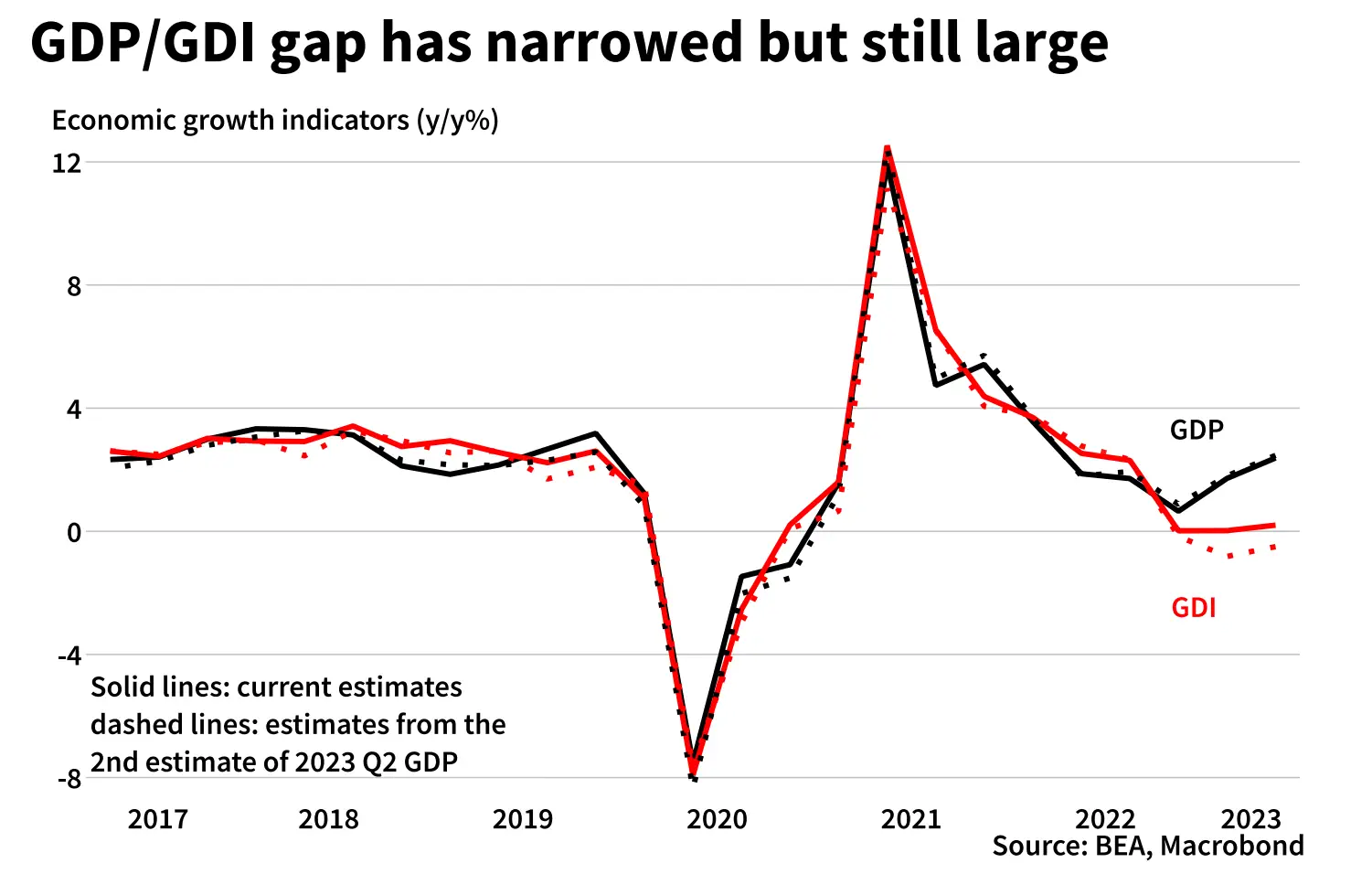
The income side revisions included noteworthy changes
to household incomes and corporate profits.
For households, while consumption was little changed,
the level of disposable income over the last two years
was revised upwards. The weakness in the level of
income relative to consumption had been a factor in our
view that consumption growth was set for a correction.
This changed picture can also be seen in the savings
rates – not only has it been revised upwards in recent
quarters, but the pre-COVID-19 level was also revised
down.
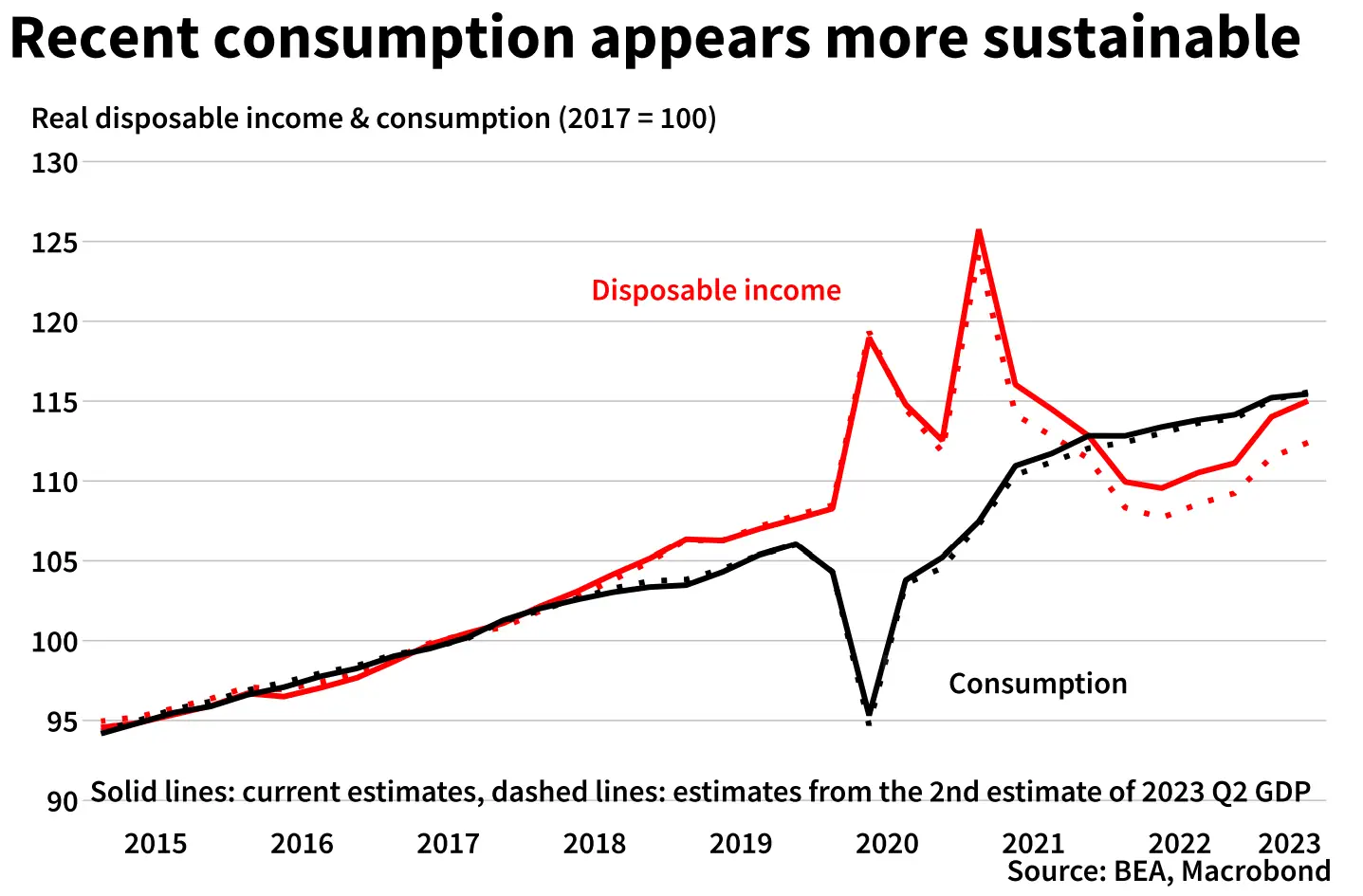
Similarly, corporate profits have been revised
substantially higher (the Q2 level between the 2nd and 3rd
estimate moved up over 10%). Profits are still estimated
to have declined from their peak, but the fall is smaller
than previously estimated.
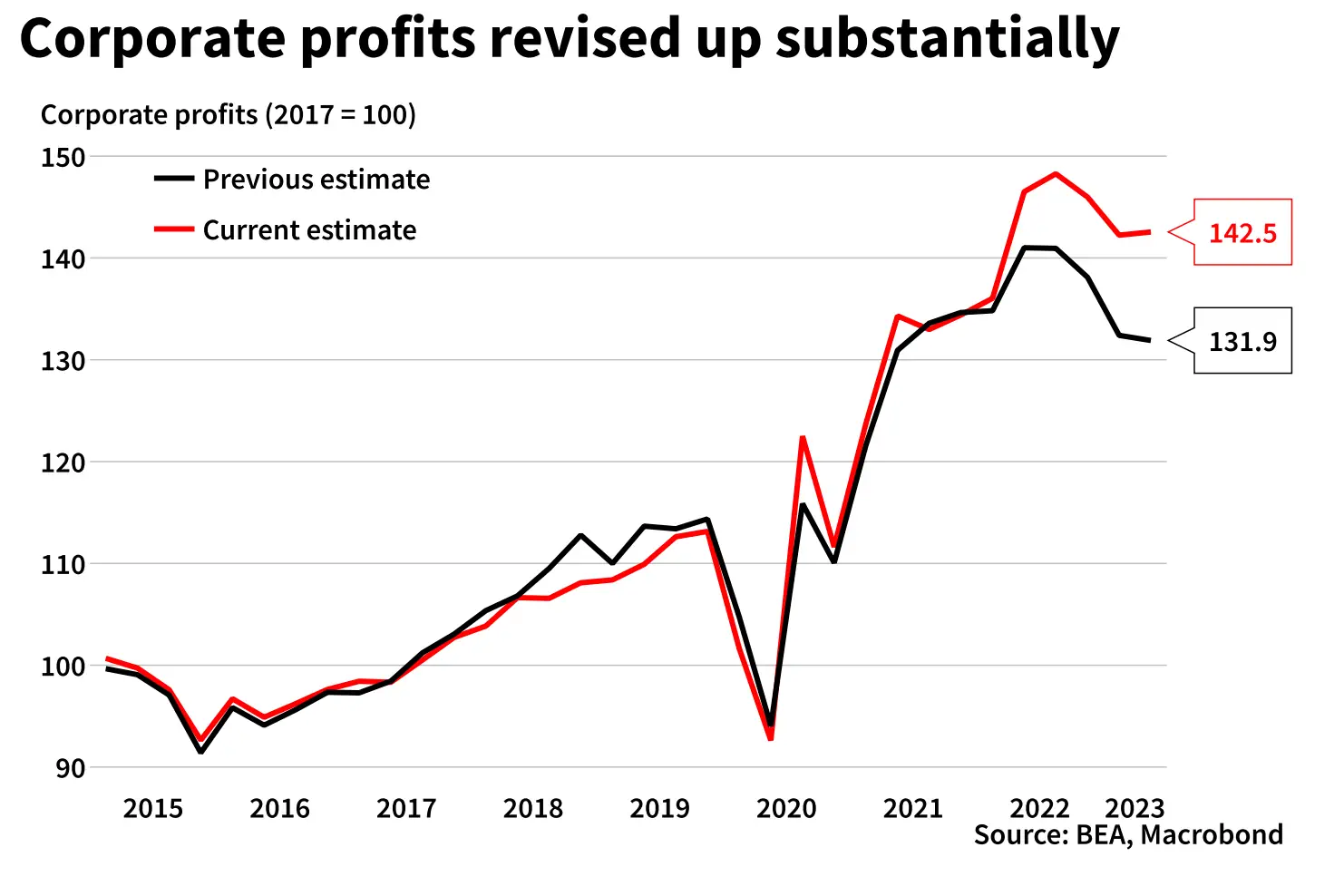
Q3 looking even stronger
Incoming data continue to point to strong GDP growth in
Q3. Last month we revised up our forecast for Q3 and
this month we take it higher again (to 4.1% q/q
annualised from 2.9% q/q).
As expected, consumption growth slowed materially
from the boomy 0.6% m/m growth seen in July, growing
by 0.1% m/m in August. However, we had expected a
small correction over August/September and with auto
sales up in September this is looking less likely.
More significant are recent net trade and inventory data.
Real goods imports declined 1.9% m/m in August, while
exports rose 0.1% m/m. This means the most likely result
is a solid net trade contribution to Q3 growth. Similarly,
inventory data available for July/August point to
stronger inventory accumulation in Q3.
The strength in Q3 is somewhat at odds with the
business surveys. The business surveys are not reliable
indicators of quarterly GDP growth but over time do tend
to follow the same trend, and so provide an independent
signal of how the economy is performing. Of note, while
still weak in level terms, the PMIs for the manufacturing
sector have shown some improvement in recent months.
The services sector remains stronger, although may have
come off in recent months, although there are wide
differences across the various surveys.
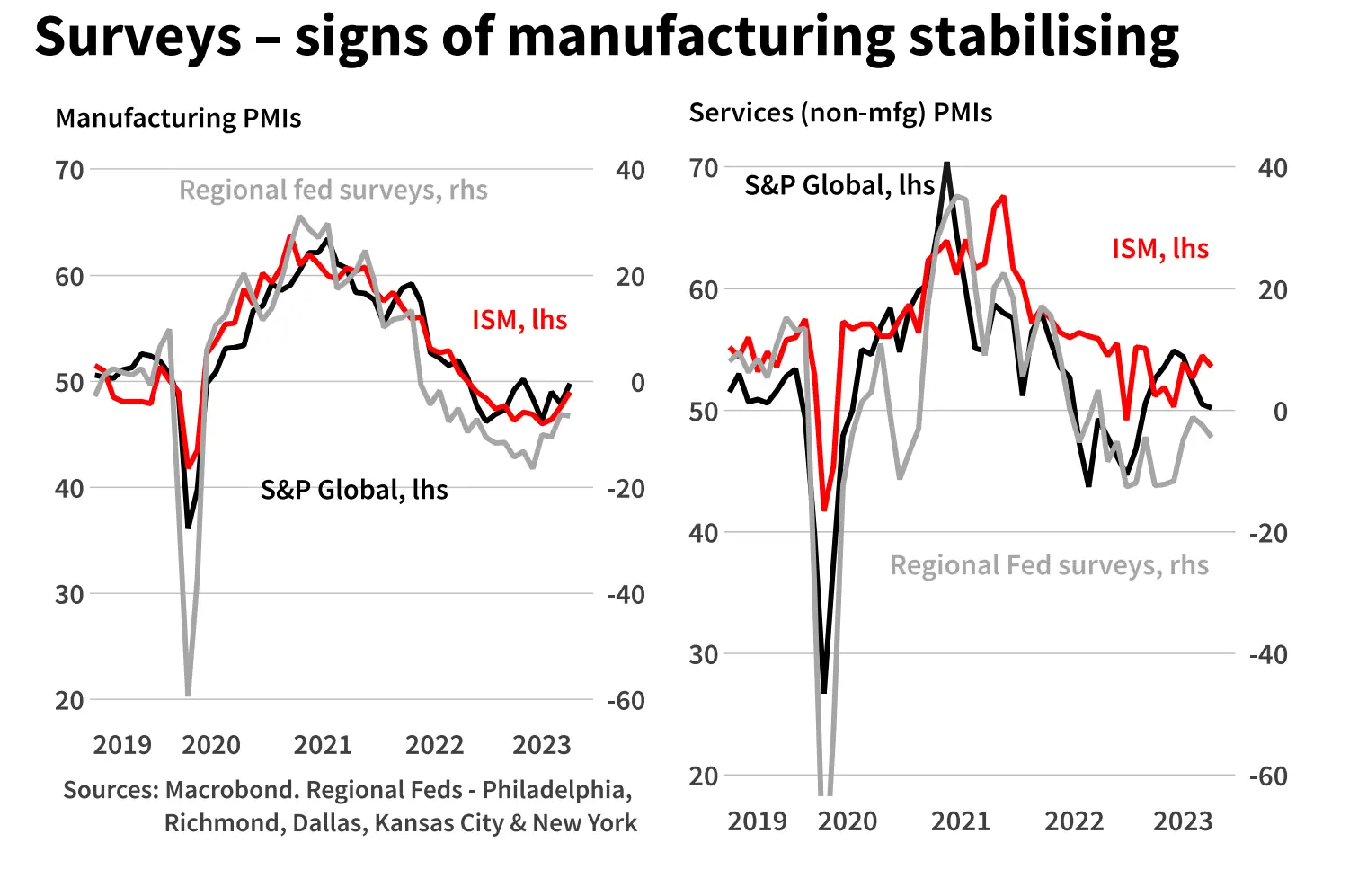
Outlook
As a result of the revisions to the household income and
corporate profit data, as well as the underlying strength
of incoming data (suggesting greater momentum in the
economy), we have lifted our forecasts for GDP growth
over the four quarters to Q2 2024. We still expect growth
to slow materially, as the full impact of past monetary
tightening comes through, but with mid-2024 the point
where it is likely to be softest (previously early 2024).
Beyond that we expect growth to start recovering, albeit
a bit more slowly than before, partly because we now
expect rates to be on hold for longer.
In year average terms, these changes see higher growth
in 2023 (2.3% from 2.1%) and growth of 1.2% in both
2024 and 2025 (previously 0.8% and 1.7% respectively).
As noted above, consumption growth was soft in August,
in part reflecting the renewed pressure on household
incomes from a lift in petrol prices. Further pressure on
household spending power will come from the re-start of
student loan interest and principal repayments. As a
result, we expect materially lower consumption growth
in Q4.
Similarly, the run up in tech related manufacturing
construction appears to have peaked (so even it remains
elevated, a further large boost to growth appears
unlikely).

The resilience in the economy – and the resulting
expectation that the Fed will keep rates high for longer
than previously thought – has also seen a lift in interest
rates with corporate bond yields, mortgages rates, bank
loan rates all shifting higher. Importantly, however,
measures of market stress remain muted. At the same
time, there has been a fall in equity prices, reversing
some of the gains in wealth that households experienced
over the first half of the year.
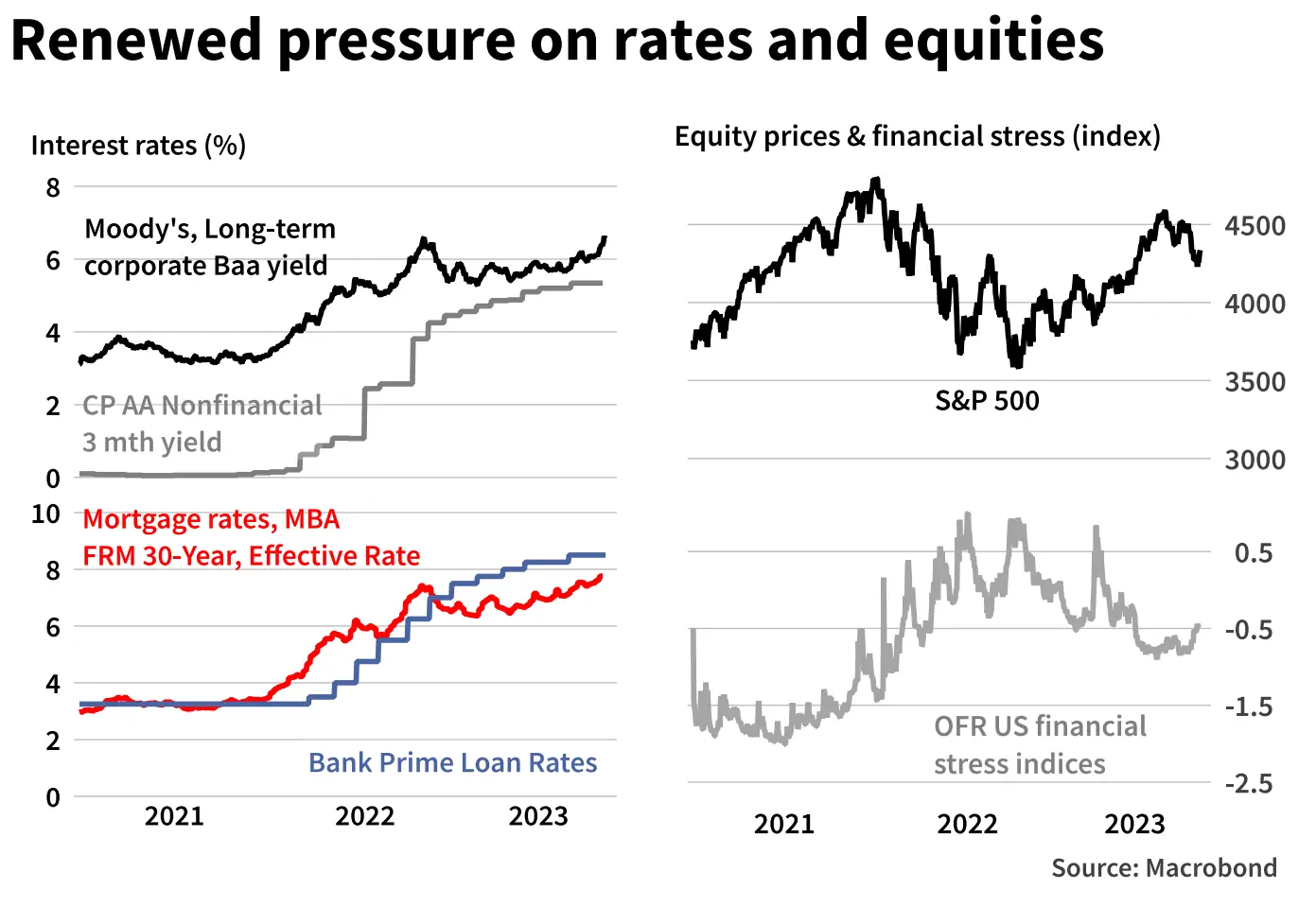
The rise in interest rates (and fall in equities) represents
a tightening in financial conditions, which, if sustained,
will constrain future activity, particularly in interest rate
sensitive sectors such as residential investment and
durables consumption. It can also impact business
investment where surveys of business capex intentions
remain soft even with some recent improvement.
Strike activity has come to the fore this year, notably the
Writers strike (May-September) and the current auto
workers strike (started mid-September). The impact of
the former on intellectual property investment is highly
uncertain and a downside risk to Q3 (and upside risk to
Q4) intellectual property investment. The impact of the
auto workers strike is also hard to determine –
September auto data held up but depending on the
duration (and breadth across manufacturing plants), it
may hold down Q4 activity.
There is also the possibility of a US Federal Government
shutdown later this year. A shutdown was only just
recently averted but funding was only extended to
17 November.
Labour market and inflation
There was notable 336k increase in non-farm
employment in September, with a solid upwards revision
to the two previous months (albeit entirely in public
sector employment). In contrast, the unemployment rate
remained at 3.8% (after jumping up to this level in
August from 3.5%) and average hourly earnings growth
was again low at 0.2% m/m.
Job vacancies for August also jumped higher, although
relative to the number of unemployed they continue to
move down.
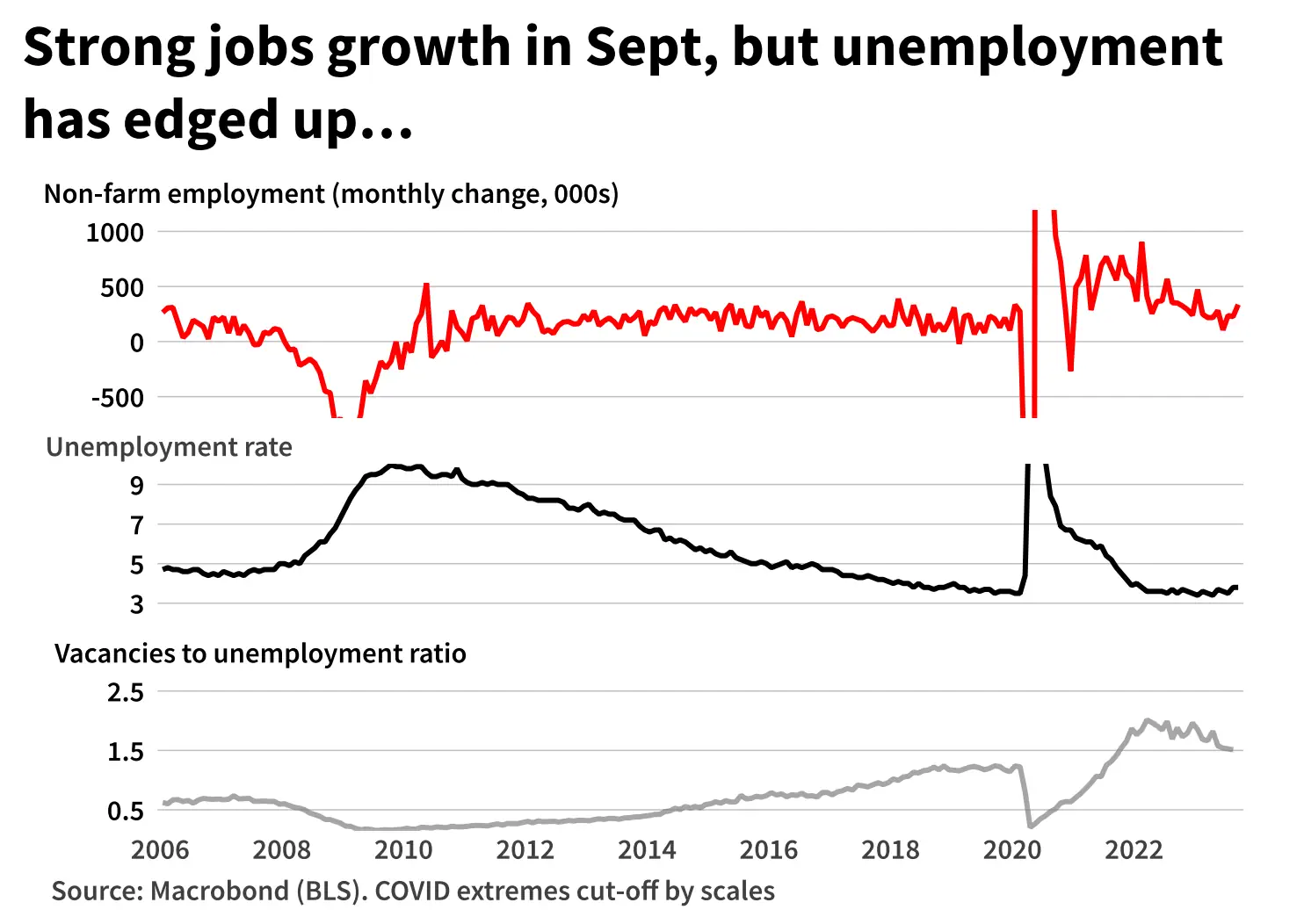
Overall, data over the last month were mixed. Monthly
data are volatile; on a quarterly basis non-farm
employment growth was little changed in Q3. It is not the
first time there has been a pause in the downwards trend
in job creation evident since early 2022. That said, even if
conditions are still easing, it is only slowly and the labour
market remains tight. The Fed’s concern with a tight
labour market is that it feeds into wages growth (and
then onto prices) but the modest growth in the August
and September hourly earnings data possibly indicates
that wage cost growth has come off further (although
again, a couple of readings are not enough to be
definitive).
On the inflation front there was mixed news for August.
Headline CPI grew 0.6% m/m – its highest level since
mid-2022. This was largely due to a rise in gasoline
prices, although the core CPI, at 0.3% m/m, was also up
on the previous two months. The Fed’s preferred
inflation measure – PCE inflation, also rose to 0.4% m/m,
but the increase in the core measure was only 0.1% m/m,
its lowest level since late 2020.
In his September FOMC press conference, the Fed Chair,
noted that monthly data can be volatile and that it is
important to look at longer time frames. While noting
that this is why they tend to look at price changes over a
12-month period, he indicated that when there has been
a turn in inflation they also look at inflation over 3 and 6
month periods. Importantly, regardless of how it is
examined, inflation is shifting down across the range of
underlying inflation measures.
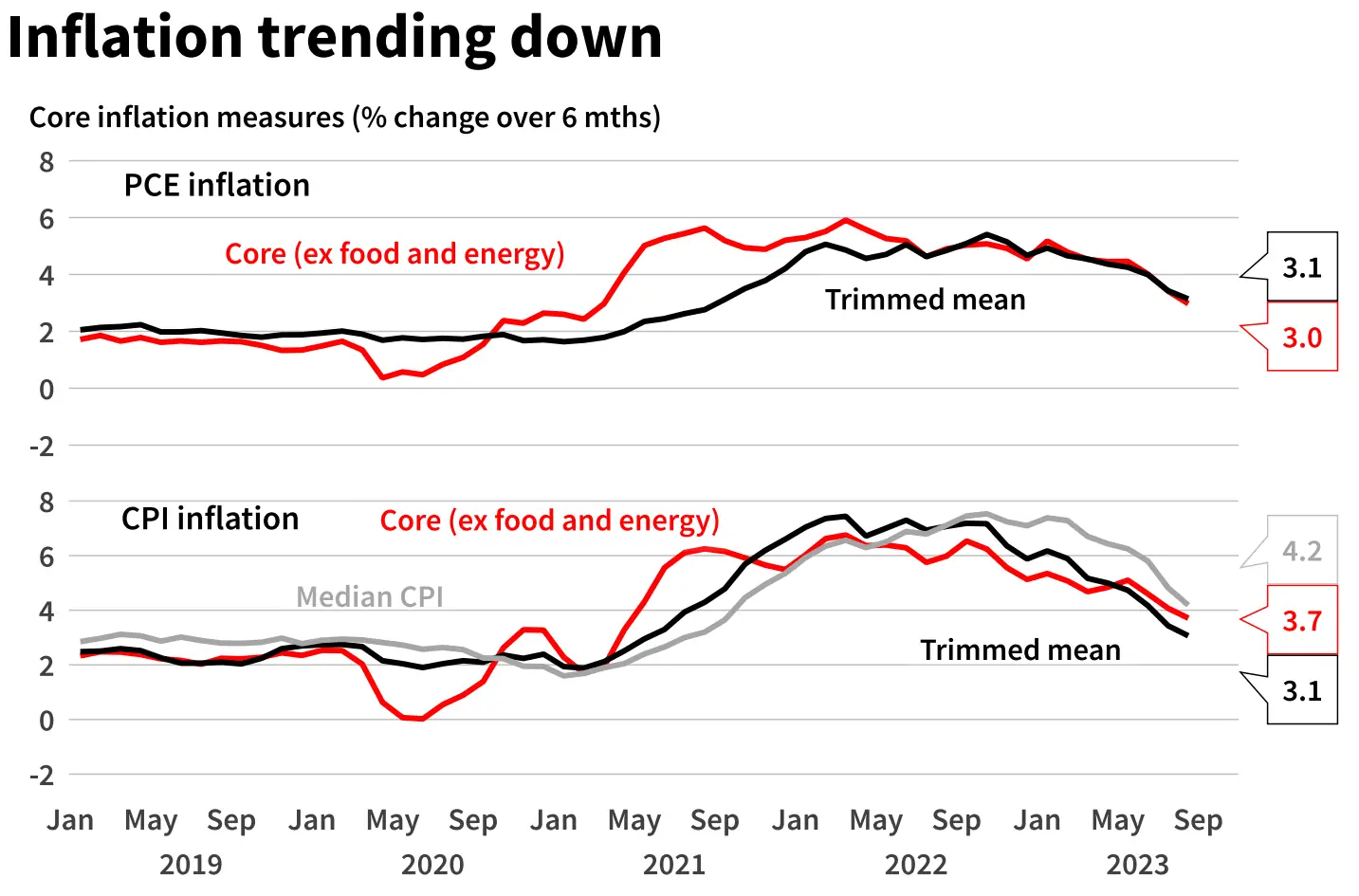
The changes to our GDP outlook now mean that, while
we still expect the unemployment rate to rise over the
next two years, it will occur more gradually. We still
expect it to rise to around 4½%, but for this level to be
reached in H1 2025 (previously H2 2024).
In contrast, we have not made material changes to the
inflation outlook. While a stronger near-term outlook for
growth and the labour market should mean, other things
equal, stronger inflation, inflation has broadly matched
our expectation in Q3. The disinflationary effects coming
from supply chain normalisation on goods prices still has
further to run – most notably for auto prices where
inventories have not fully recovered – especially when
coupled with the softness in the global economy.
Housing services inflation will almost certainly continue
to decline given trends in rents for new leases.
A key uncertainty remains at what level inflation will
settle once some of these (dare we say ‘transitory’)
factors pushing inflation down subside. However, with
most measures of inflation expectations still well
anchored, we retain our forecast that inflation will move
close to the Fed’s 2% target.
Monetary policy
At its meeting this month the Federal Reserve
maintained the target range for the federal funds rate at
5.25% to 5.50%.
New Fed member economic projections were released
following the meeting. The Fed median projections for
GDP growth over 2023 and 2024 were revised up.
Consistent with this, the expected unemployment rate
was lowered. The median inflation forecasts did not shift
much – slightly lower in 2023 and, for core PCE inflation,
slightly higher in 2025 but the 2024 forecast was
unchanged.
For the federal funds rate, the median projection for end
2023 remains at 5.50-5.75% (i.e. one more hike this year).
While retaining an expectation of rate cuts next year, the
amount has been halved (50bps compared to 100bps
previously). Despite the resilience in the economy
to-date in the face of the large lift in rates, the Fed’s view
of the long-run level of the funds rate (‘neutral’) remains
at 2.5%. That said, even while projecting inflation, the
unemployment rate and GDP growth to be at their longrun level in 2026, the fed funds rate projection at the end
of the year is 2.9%, above ‘neutral’.
In terms of whether the Fed will increase rates one more
time this year, this is clearly possible, but we retain our
view that it will remain on hold given the better run of
inflation data of late.
In August, the Fed Chair stated that “Evidence that the
tightness in the labor market is no longer easing could
also call for a monetary policy response.” So it was little
surprise that the strong jobs growth reported for
September lifted market expectations of the chance of a
rate hike, but it subsequently fell back. At the time of
writing, market pricing implies around a 25% chance of a
rate hike by the end of this year. The improvement in
inflation outcomes may be enough to stay the Fed’s
hand – but clearly, if the next 1-2 months of inflation
data are on the high side, the chance of a rate hike will
go from possible to probable. The Employment Cost
Index for Q3 will also be an important marker, with the
Fed looking for further signs that wage growth is
moderating. Given the inherent volatility in monthly data
around its underlying trend, the decision could go either
way.
With the change to our economic forecasts, we have
pushed out when we expect the Fed to start cutting rates
to June 2024 (previously March 2024). We also expect a
slower pace of cuts to start – one a quarter – initially but
as unemployment rises further and it is clear the
moderation in inflation is entrenched then we think they
are likely to start cutting at each meeting.
This still leaves a lower track for the fed funds rate than
in the median Fed member projections. This is consistent
with our more pessimistic view for GDP growth and the
unemployment rate, and our forecast that inflation will
be lower in 2024 than the Fed expects.
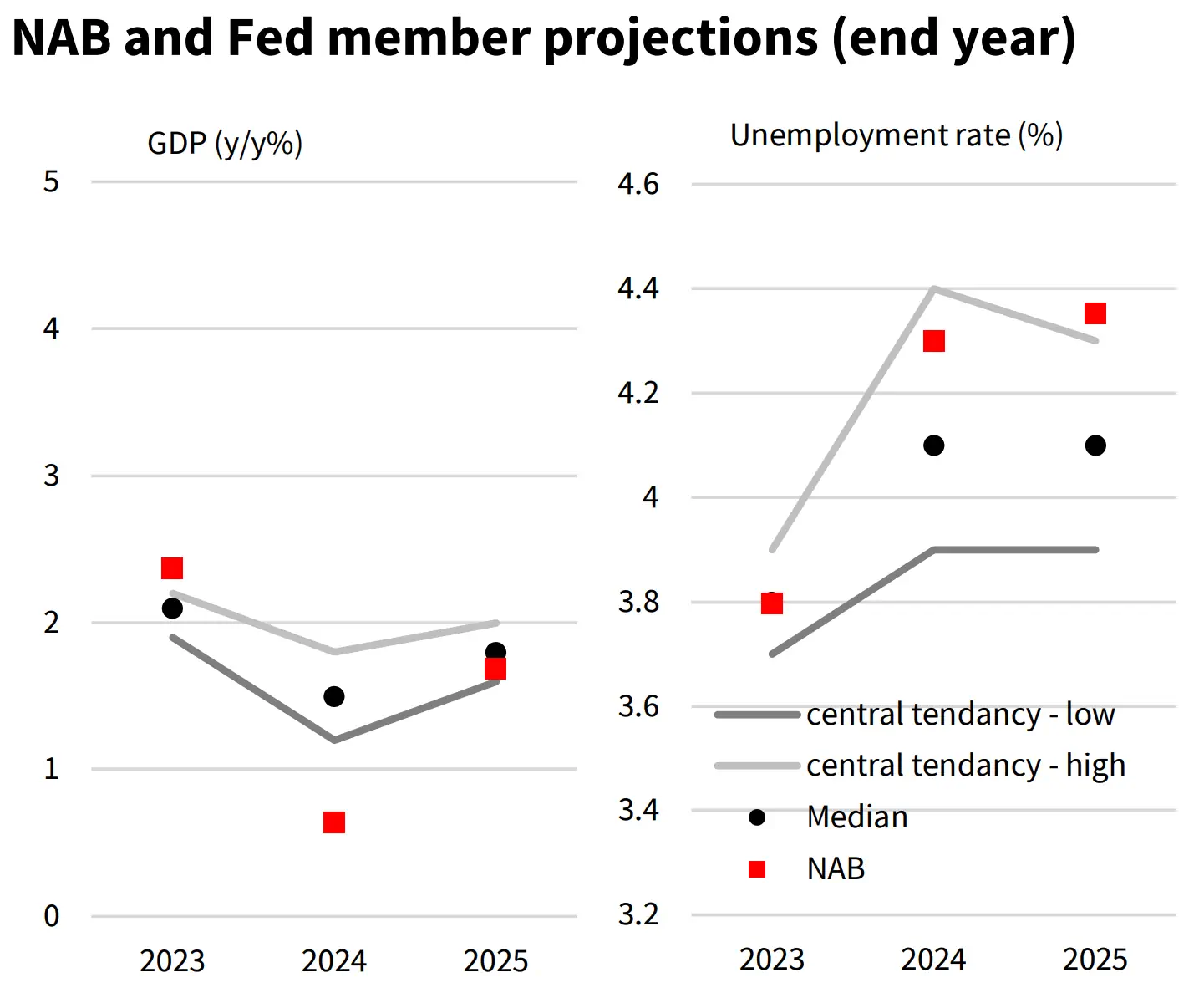
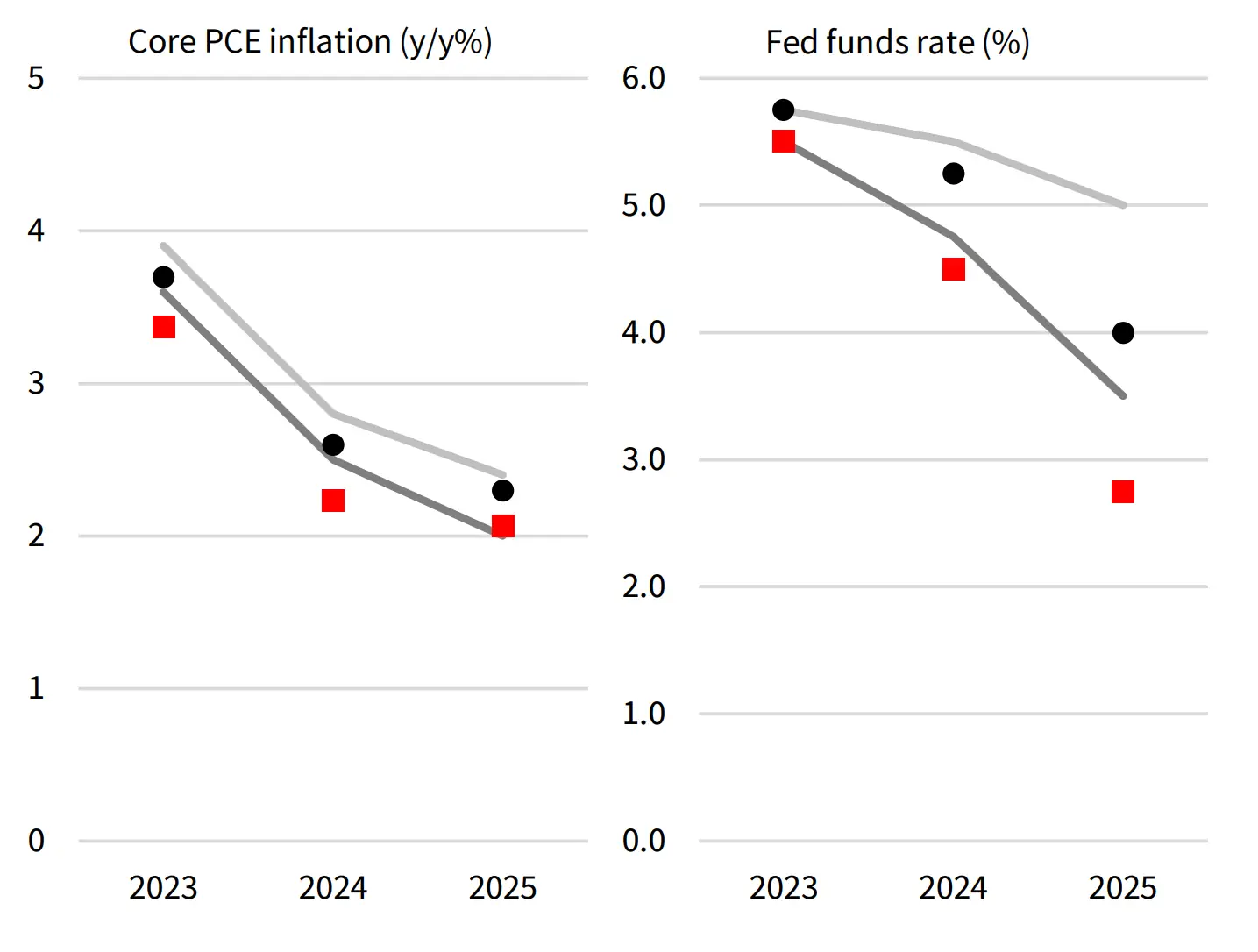
More broadly, the risks around this rate call mirror the
uncertainties around our economic projections. Inflation
outcomes will be central to this and there are upside and
downside risks to the inflation outlook. Moreover, rates
may end up lower than expected over the forecast period
if, as is the historical experience for monetary policy
tightening of the magnitude experienced, the economy
goes into recession. Conversely if growth, and the labour
market, continues to out-perform expectations,
particularly if this adds to inflation pressures, then rates
could be on hold for longer (or even move higher).
Growth outperformance would also see the Fed revise up
its view of ‘neutral’ which may affect the extent of rate
cuts.
Contact the author:
Tony Kelly
Senior Economist
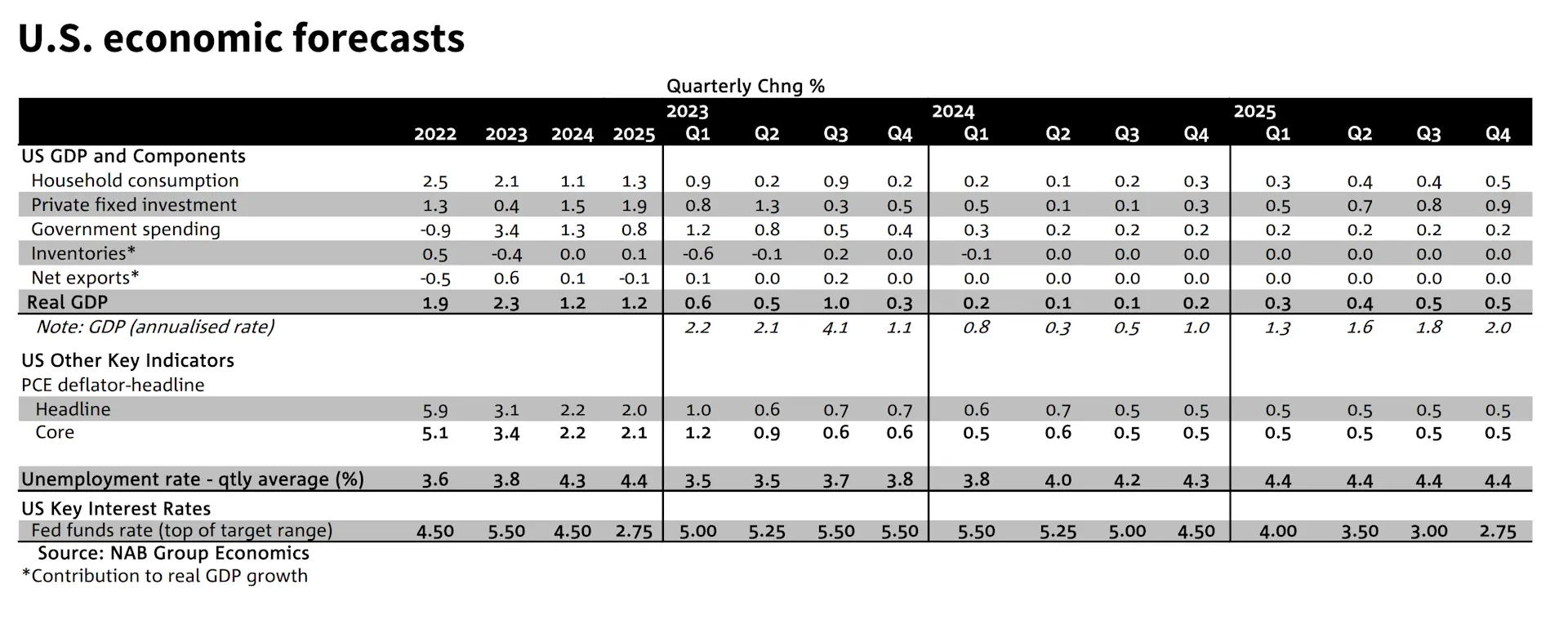
Group Economics
Alan Oster
Group Chief Economist
+(61 0) 414 444 652
Dean Pearson
Head of Behavioural &
Industry Economics
+(61 0) 457 517 342
Jacqui Brand
Personal Assistant
+(61 0) 477 716 540
Australian Economics
and Commodities
Gareth Spence
Senior Economist
+(61 0) 436 606 175
Brody Viney
Senior Economist
+(61 0) 452 673 400
Behavioural & Industry
Economics
Robert De Iure
Senior Economist –
Behavioural & Industry
Economics
+(61 0) 477 723 769
Brien McDonald
Senior Economist –
Behavioural & Industry
Economics
+(61 0) 455 052 520
International
Economics
Tony Kelly
Senior Economist
+61 (0)477 746 237
Gerard Burg
Senior Economist –
International
+(61 0) 477 723 768
Global Markets Research
Skye Masters
Head of Markets Strategy
Markets, Corporate &
Institutional Banking
+(61 2) 9295 1196
Important notice
This document has been prepared by National Australia Bank Limited ABN 12 004 044 937 AFSL 230686 (“NAB”). Any advice
contained in this document has been prepared without taking into account your objectives, financial situation or needs.
Before acting on any advice in this document, NAB recommends that you consider whether the advice is appropriate for
your circumstances.
NAB recommends that you obtain and consider the relevant Product Disclosure Statement or other disclosure document,
before making any decision about a product including whether to acquire or to continue to hold it.
Please click here to view our disclaimer and terms of use.
